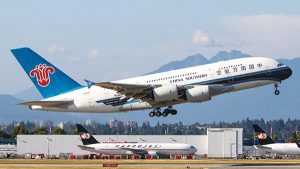Bloomberg
Passenger loads at China’s top three airlines are rebounding as travel picks up again, boosted by people flying back to their hometowns for the Lunar New Year holidays and celebrating the chance to reunite with families and friends after nearly three years of Covid restrictions.
China Southern Airlines Co filled 72.7% of its seats in January, the highest passenger load factor among the trio, exchange filings show. That was up from 63% a year ago. Air China Ltd was next, with a passenger load factor of 69.9% for the month, followed by China Eastern Airlines Corp, at 68.3%.
Passenger load factor is the percentage of seats that have been filled on a plane, and is an indicator of profitability.
China Southern’s Hong Kong-listed shares rose as much as 3.7%, while China Eastern jumped 5.1% and Air China added 5.7%. All three have climbed more than 17% since the start of December.
The nation’s largest three carriers lost 190 billion yuan ($27.7 billion) over the last three years as Covid upended travel, company filings showed last month. Losses accelerated in 2022, when authorities persisted with lockdowns and mandatory quarantine to contain the virus, even as the rest of the world moved on and reopened.
In addition to the disruption caused by the pandemic, the Chinese airlines have said they were affected by high oil prices and a weaker yuan, which dropped about 8% against the dollar last year. Caixin recently said that several state-owned airlines had been criticised by Beijing for offering cut-price tickets in order to fill seats.
The Civil Aviation Administration of China (CAAC), which denied that charge, has in the past imposed restrictions on cheap tickets, saying in 2021 it wanted to avoid malicious competition that may cause “cabbage pricesâ€.
A CAAC official said that China expects the number of international flights to rebound to between 15% and 25% of levels before the pandemic by the end of March. International flight passenger traffic improved in January, the Shanghai Securities News reported.
 The Gulf Time Newspaper One of the finest business newspapers in the UAE brought to you by our professional writers and editors.
The Gulf Time Newspaper One of the finest business newspapers in the UAE brought to you by our professional writers and editors.
